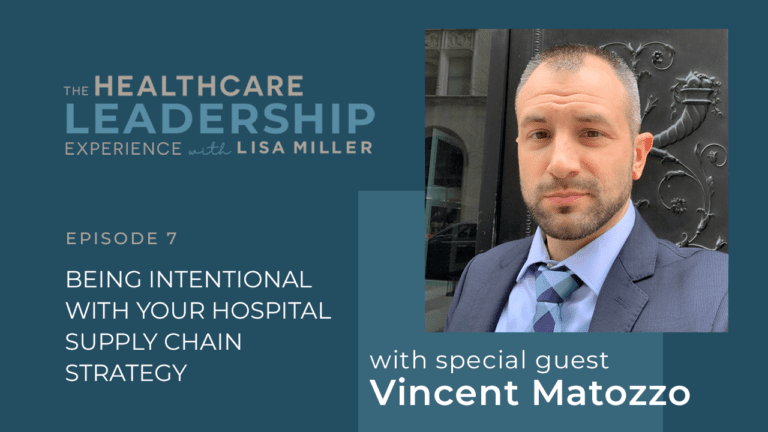Episode Introduction
As hospitals struggle with spiraling costs, Lisa Miller reveals seven key ways to save money in the next 12 months. Topics Include how ‘’flickering’’ helps to reflect on cost initiatives, the need for a Chief Expense Officer, the midterm contract reviews that helped to save one hospital over $19 million, and how data creates a 14% cost shift when presented to physicians.
Show Topics
- Adopt a comprehensive approach to cost savings
- Hospitals need a Vice-President of Costs (or equivalent)
- Successful contract management requires a mid-term review strategy
- The benefits of zero based budgeting
- Insource versus outsourcing
- Raising physician cost awareness
- Creating a cost-conscious culture in hospitals
O1:30 Adopt a comprehensive approach to cost savings
Lisa challenged hospitals on how much insight they have into their cost savings projects.
‘’So what I mean by this is today, if you’re a C-suite leader or you’re a supply chain leader, if you wanted to know every single cost savings project that’s going on in your organization, could you open up an Excel, some kind of dashboard, platform or something, and have line of sight into every single one? And my experience has said, when I’ve asked that question, that 100% have said, “No. We do not house every single initiative that’s going on in the organization.” And I think that bringing these initiatives all together so you get a complete picture with complete visibility, cohesiveness, understanding what’s going on, and of course that terrible A-word which is accountability, bringing it all together, we’ll have just another level of savings because you just have a complete view. And so I challenge anyone that’s listening to the podcast today… I’m going to tell you that the effort to just house everything together is literally … game changing for a lot of reasons. And I’ll talk about those for a moment. But I want to give you one more nuanced thought…..Could you go back 12 months or go back in the last six months and say, “Okay, what are all the initiatives we worked on and what will be completed?…..my number one advice is to pull those projects together…. get a complete picture, invest in that time.’’
#2 Hospitals need a Vice President of Costs (or equivalent)
09:00 Lisa explained why every health system would benefit from a position that focuses on costs
‘’This vice president of costs or this person who just focuses on costs where they can have line of sight to everybody and they work with everybody. …. last month, just by accident, I came across somebody, and I’m hoping that I get that person on this podcast soon…they do have a title and I’ve researched it since then. And there’s a few of these titles out there. The title is Chief Expense Officer. I’ve taken an excerpt from their LinkedIn page and it says, “Senior leader collaborating with the health systems’ clinical and administrative leadership to identify opportunities to create value.” There’s also this really great line, and I think I’m going to say this super slow. I might repeat it. It says, “Leveraging experience in expense management and analytics to reduce waste and unwarranted variation and eliminate excess cost. Leveraging experience in expense management and analytics to reduce waste and unwarranted variation and eliminate excess cost.” .. their job is a Chief Expense Officer. So I feel like that’s an innovation for hospitals. Again, an innovation is a process. It’s a way to think about their business, a new position, right? Innovative positions. And I think that Chief Expense Officer is an innovative position. And I had in years past said there really needs to be this Vice President of Cost or of Costing or Cost Structure. But you can have a VP of Expense, but this, another CEO, Chief Expense Officer, I think makes a whole lot of sense.’’
12:00 Successful contract management requires a midterm review strategy
Lisa shared how her team identified over $19 million of cost savings carrying out midterm contract reviews for one hospital.
‘’Everybody has a strategy for contract renewals. So when renewals come up there’s a strategy, an RFP strategy or a renegotiation strategy. There’s a strategy for net new, going out to the market. And again, it could be RFP or it could be a rigorous internal process. But I does feel like there’s really, again, an innovative process to look at your contracts, and that’s having a midterm strategy. And so having a midterm agreement strategy means that you’ve got probably a large amount of your agreements now, maybe 50 to 60% of them that aren’t coming due in the next year, 18 months. They’re in that three to five year, three to seven-year cycle. And so that usually gets tucked away and like, “Oh, we’re going to do that in the next two or three years.” But I think every hospital at some point or other, you can’t do this all the time, but at some point they put a stake in the ground and say, “We’re going to look at all of our agreements that are in midterm and we’re going to benchmark them. We’re going to analyze them.” And we had done that for a lot of our hospitals. We actually did this for one health system just for their IT. They were a large IDN, several hospitals. The CIO wanted to look at all their agreements. In particular, wanted a company that had expertise looking at contracts midterm and could renegotiate them… we looked back after about two and a half years and saved them over 19 million dollars.. some of the greatest savings came from the midterm agreement renegotiations. Now if you think about it, these are agreements that wouldn’t have been looked at for years.’’
19:00 The benefits of zero based budgeting
Lisa outlined the financial benefits for hospitals adopting zero based budgeting.
‘’..Zero based budgeting essentially is assuming, given your budget is zero, and now you’ve got to explain everything you want to put into your budget versus having a budget and saying, “I’m going to keep that same budget for 2023 or 2024 and I’m going to plus or minus five or 10%,” or there’s some kind of way you look at it. You can look at it rolling 12 months, rolling three months, versus saying, “I’ve got to explain everything I’m going to put in.” And that is just a really high performing way to look at your budget. And we’ve done that with hospitals, taken away the heavy lift part of it because it is a bit of a heavy lift and really it’s just been remarkable how much we take out by taking that approach.’’
20:00 Insourcing versus outsourcing
Lisa said hospitals that outsource should make 2023 the year to carry out an in-depth analysis to ensure it is still cost effective.
‘’You could, right now, insource your dietary and you may in the past have taken analysis to look at, well, what it would save us or what would be the benefits of outsourcing? I think this year we’ve got to look at that again. And so much has changed. It may be very beneficial to outsource dietary or, for your hospital, it may be really beneficial to insource. Lisa, you and I talked on the past episode about food costs and maybe it would make sense to bring in dietary and use local providers for dietary that could bring down costs. Years ago, I remember having school lunches and I’ve had community members or family members who actually did the cooking for the school. This is way back because I’m aging myself a little bit, where you would have people cooking in the back and you’d have really well prepared lunches for schools versus some of the things that may happen now versus home lunch. So what innovative ways could a hospital say, listen, maybe we want to insource it and maybe we want to use the local community. Maybe that’s the way you don’t want to outsource anymore because the outsourcing costs too much. But I think the whole idea around this is that whatever you’re looking at internally that you’ve insourced, that’s not a core business, consider the analysis to outsource.’’
24:30 Raising physician cost awareness
Lisa explained why consistency in providing cost data to physicians can result in significant cost savings.
‘’Physicians, their decisions drive about 70% of costs in organization. And so I feel like we don’t do a good enough job at showing physicians their cost. It’s not telling them how to do business. We, of course, sometimes have to get them aligned when there’s a cost savings initiative. But sometimes it’s simple as just telling them, showing them where their costs are and showing them the numbers. And I feel like … I often say they’re scientists. If you give them the data and the information and given some comparisons in a very smart analytical way, they’re going to make some really great decisions. We just don’t do it, give it to them in a way that’s meaningful and then we don’t do it consistently, if we do it at all. And they were frustrated that when we come to them for a cost savings initiative, maybe there’s a little bit of conflict because that’s the only time we come to them. So I think this physician cost awareness, in a really collaborative way, getting a champion and putting that together, again, it requires some planning and maybe some outside resources to help you with that, but it’s really important. There’s a study that shows that they had two groups of physicians in a surgical line in the OR, and just by showing this one group of physicians their cost … they just showed it to them, they didn’t tell them they wanted anything. They reduced their costs by 7.2%, just showing them the data. The control group, which didn’t get the pricing data, the cost, they had an increase in that same time period of like 6.7%. So if you can imagine, there’s this shift of 14%, right, by just showing physicians the cost information. And the ones who didn’t see it, they just had a natural increase in their cost. So why aren’t we just using this very innovative, simple way? ‘’
29:30 Creating a cost-conscious culture in hospitals
Lisa said the key motivator for a cost-conscious culture is the delivery of better patient care.
‘’I think we just need to have more cost conversations. Everything from what a welcome bag may cost. You want to have welcome bags, what are included. To these higher cost items, to being on the front lines and seeing things that somebody could raise their hand and say wait a minute, I want to be a part of this culture of cost awareness and cost consciousness, but I have to have an environment there’s safety in that environment. Where people are going to listen and kind of support that. But I think there’s a lot that goes on in the front lines that have a tremendous magnitude overall. So we’ve got to have this culture. So it’s a positive culture. Listen, we’re doing this for patient care. It’s cost aware for patient care. It’s something I’ve written about quite a bit. That’s why we’re doing it. We’re not doing it for any other reason. It’s not to be a downer, but it’s really to uplift the organization, save jobs, really be great stewards.’’
Show Links
Connect with Lisa Miller on LinkedIn
Connect with Jim Cagliostro on LinkedIn
Connect with Lisa Larter on LinkedIn
Check out VIE Healthcare and SpendMend
You’ll Also Hear:
How ‘’flickering’’ can help hospitals in their reflections on cost savings initiatives. ‘’That’s why I if you have a plan, You can go back and flicker back and forth to say, “Well, what do we do? What did we thought we were going to do? Why didn’t we do it?”
The need to be aware of price creep in every contract – and how a monthly or quarterly review can prevent that.
Why it always comes back to the data in every cost analysis. ‘’… look at the data and then you might make the decision that you may not want to do that this year, it could be a 2024 project.’’
Becoming wiser in engaging physicians. ‘’We wouldn’t walk in to any kind of store and just not look at a price tag. I just don’t think we’re being wise about how we engage physicians.’’
Creating a movement within a hospital: cost savings innovation from Lisa Larter. ‘’My idea for hospitals is when you explain to people what the cause is, what the mission is and why it matters and you get people to understand and then you reward and celebrate people when they have cost savings ideas, you start to really change the culture.’’
What To Do Next:
- Subscribe to The Economics of Healthcare and receive a special report on 15 Effective Cost Savings Strategies.
2.There are three ways to work with VIE Healthcare:
- Benchmark a vendor contract – either an existing contract or a new agreement.
- We can support your team with their cost savings initiatives to add resources and expertise. We set a bold cost savings goal and work together to achieve it.
- VIE can perform a cost savings opportunity assessment. We dig deep into all of your spend and uncover unique areas of cost savings.
If you are interested in learning more, the quickest way to get your questions answered is to speak with Lisa Miller at lmiller@spendmend.com or directly at 732-319-5700
Episode Transcript
DOWNLOAD THE PDF TRANSCRIPT HERE
CLICK HERE TO OPEN THE FULL TRANSCRIPT
Lisa Miller (00:01)
2023 is the year that hospitals need to take a midterm agreement strategy to aggressively, rigorously look at contracts midterm — and benchmark, analyze them. And the ones that have the greatest opportunity for savings, they need to go out and renegotiate it, and reset those well before the term expires.
Introduction (00:22):
Welcome to The Healthcare Leadership Experience Podcast hosted by Lisa Miller and Jim Cagliostro. Lisa is the founder of VIE Healthcare Consulting and now managing director at SpendMend. Lisa and her team has generated over $1 billion in financial improvements for VIE’s clients since 1999.
Since 2007, Jim has been a registered nurse working in critical care, perioperative services, and outpatient settings at nationally recognized medical facilities across three states.
You’ll hear conversations on relevant and trending topics in healthcare and much more. Now here’s your hosts, Lisa and Jim.
Lisa Miller (01:00):
Hi. This is Lisa Miller, and this is the Healthcare Leadership Experience Podcast. And so we are in 2023, and I have Lisa Larter, our producer, on the show with me today. Welcome, Lisa.
Lisa Larter (01:15):
Thank you. It’s good to be here with you.
Lisa Miller (01:18):
It’s great. Been enjoying these series with you. They’re always, I think, way more interesting, informative, and fun, and we’ve gotten great feedback when you are on the show, so I am thrilled that you’re back on the show with us for a few episodes.
Lisa Larter (01:33):
Thanks.
Lisa Miller (01:35):
So today, we are going to be talking about new, innovative, cost-saving ideas to help hospitals save money in 2023. So, 2022 was an interesting year. We had my reflection on our past podcast, and now we are looking towards 2023. So, I’m just going to jump in and, Lisa, I will ask you some questions too during this podcast. I’m always kind of throwing you off a little bit, but you do great. Getting your feedback from a non-healthcare person, I think, is really important.
Lisa Miller (02:10):
So, I’m going to start with something that I really think is really … Maybe seem a little over simplistic, but it’s not done, and I think it really needs to be a displayed in 2023, and that is taking a comprehensive approach to your cost-savings initiative. So, what I mean by this is today, if you’re a C-suite leader or you’re a supply chain leader, if you wanted to know every single cost savings project that’s going on in your organization, could you open up an Excel, some kind of dashboard, platform or something, and have line of sight into every single one? And my experience has said, when I’ve asked that question, that 100% have said, “No. We do not house every single initiative that’s going on in the organization.” And I think that bringing these initiatives all together so you get a complete picture with complete visibility, cohesiveness, understanding what’s going on, and of course that terrible A-word which is accountability, bringing it all together, we’ll have just another level of savings because you just have a complete view.
Lisa Miller (03:34):
And so I challenge anyone that’s listening to the podcast today, that yes, it seems like what’s a lot of work and there’s people doing different things, and how do you even bring it together? I’m going to tell you that the effort to just house everything together is literally … It’s an overused word, but it’s literally game changing for a lot of reasons. And I’ll talk about those for a moment. But I want to give you one more nuanced thought. And this is, could you go back in time? Could you go back 12 months or go back in the last six months and say, “Okay, what are all the initiatives we worked on and what will be completed?” So, what’s the flicker? We had planned to work on these 40 initiatives, we completed 20. And to be able to flicker back and forth and say, “Well, what do we accomplish? Why didn’t we accomplish the ones we thought we were going to accomplish?” That’s the importance of being able to reflect, or again, I’m going to bring a word that Keith Cuttingham uses, flickering. That’s why I if you have a plan, you can go back and flicker back and forth to say, “Well, what do we do? What did we thought we were going to do? Why didn’t we do it?”
Lisa Miller (04:40):
So can you go back? But now when we’re in 2023, my number one advice is to pull those projects together. You probably have several consultants, you have department leaders, you have all these initiatives going on. Pull them all together, get a complete picture, invest in that time.
Lisa Larter (04:45)):
That’s really good advice. It’s really good advice, not only just for hospitals, but you’re making me think about my own business and the different projects that I have going on at any given time, and making sure that there is a place where you have visibility to everything. Because when you don’t have visibility to everything, certain things, we’re all human, we’re all busy, we all get distracted. We forget about things, we forget about initiatives that get started. So we need a mechanism that makes it easy for us to not only remember, but to inspect what we expect.
Lisa Miller (005:34):
Absolutely. Inspect what we expect. And it’s funny, when you were saying that about your business, it’s such a great point too, because we’re all working on so many things. So, to have it in one place and have that view, it’s really just almost basic management 101. But I just find that as it relates to these cost savings initiatives, there’s so much that’s going on. And there may be that leader that doesn’t know something’s going on in a specific department, but it’s tied to something he or she’s working on, or that they may want to get involved. Or maybe they should or could, and it’s just this whole collective working together, thinking visibility is so important, and it’s just a really smart way to do business. Put it all around in one place, and you could have the lead or performance improvement, or even just create a new position, which I think would have a tremendous ROI just to project management, or make sure that these initiatives are housed in one place, and they get updated.
Lisa Miller (06:38):
But I think that’s just number one for me. It’s innovative because it’s an innovative process. Not all innovation has to be tied towards technology, it has to be tied to a robot or AI. A lot of innovation comes from innovative processes. In fact, it’s probably one of the biggest points of innovation is innovative processes. And we don’t always think about that, right Lisa?
Lisa Larter (07:00):
Yeah. And the other thing that’s coming to mind for me, as you describe this, is the dilution of effort. When you don’t have visibility to all the projects, there can be so many little things that are taking up a lot of effort that maybe you don’t even care about. Because maybe if you prioritize your cost savings initiatives, maybe you want all hands on the top three, instead of having the dilution of effort on some of these little projects that really aren’t going to move the needle. If you don’t have visibility, you don’t actually know where people are spending their time.
Lisa Miller (07:33):
That is very, very wisely said. Because you can only work on a certain amount of things. And I think that the dilution is a problem, because there’s only so many priorities, and the word priority you can only do one or two of them. And we have so many priorities and nothing becomes a priority. And you’re right, creating the visibility would marshal the efforts better. You’d have better outcomes. So that’s a great point. It does go back to my previous podcast that we talked about, dysfunction one, which we’ll talk about later, all five of them. But again, it’s got me thinking about this, the five dysfunctions of a team.
Lisa Miller (08:11):
And I think you bring up a really good point, but it’s an intention to results, or avoidance of accountability, or those things fall in some manner. It may not be overt, but there just could be the fact that there’s just limited resources or amount of time, and then it doesn’t get to … There’s a little lessened intention to results only because of bandwidth. So, I think that’s a great point.
Lisa Miller (08:33):
So that’s number one. Number two, which I had written about years ago, and I stumbled across this recently, but I’d written about really having this vice president of costs or this person who just focuses on costs where they can have line of sight to everybody, and they work with everybody. It’s not like people report in. They’re really this person that gets to work with everyone equal in the organization. On supply chain departments, finance, clinicians-
Lisa Miller (09:03):
… supply chain departments, finance, clinicians. And having that one person that just is unique in the organization that can pull people together, and departments and initiatives that focuses just on cost — to me, was just a position or an innovation that hospitals could use and really get a lot out of that.
Lisa Miller (09:23):
So last month, just by accident, I came across somebody, and I’m hoping that I get that person on this podcast soon. So, I’m not going to disclose where they’re from or who they are. But they do have a title and I’ve researched it now since then. And there’s a few of these titles out there. The title is Chief Expense Officer.
Lisa Larter (09:48):
Wow!
Lisa Miller (09:49):
I’ve taken an excerpt from their LinkedIn page, and it says, “Senior leader collaborating with the health systems’ clinical and administrative leadership to identify opportunities to create value.”
Lisa Miller (10:01):
There’s also this really great line, and I think I’m going to say this super slow. I might repeat it. It says, “Leveraging experience in expense management and analytics to reduce waste and unwarranted variation and eliminate excess cost. Leveraging experience in expense management and analytics to reduce waste and unwarranted variation and eliminate excess cost.”
Lisa Miller (10:28):
That is just brilliant. One person-
Lisa Larter (10:30):
Remarkable.
Lisa Miller (10:31):
… their job is a Chief Expense Officer. So I feel like that’s an innovation for hospitals. Again, an innovation is a process. It’s a way to think about their business, a new position, right? Innovative positions. And I think that Chief Expense Officer is an innovative position.
Lisa Miller (10:50):
And I had in years past said there really needs to be this Vice President of Cost or of Costing or Cost Structure. But you can have a VP of Expense, but this, another CEO, Chief Expense Officer, I think makes a whole lot of sense.
Lisa Miller (11:01):
But whatever you call it’s the person, the position that is unique in the organization that really can pull everything together. That this exercise of expense management and expense reduction requires individual focus. And I guess that’s the theme and that’s the spirit of the idea, right, is one person’s job to pull it all together. So-
Lisa Larter (11:27):
That’s great.
Lisa Miller (11:28):
… that’s number two.
Lisa Miller (11:30):
Number three. Everybody has a strategy for contract renewals. So, when renewals come up there’s a strategy, an RFP strategy or a renegotiation strategy. There’s a strategy for net new, going out to the market. And again, it could be RFP, or it could be a rigorous internal process. But I do feel like there’s really, again, an innovative process to look at your contracts, and that’s having a midterm strategy.
Lisa Miller (11:59):
And so having a midterm agreement strategy means that you’ve got probably a large amount of your agreements now, maybe 50 to 60% of them that aren’t coming due in the next year, 18 months. They’re in that three to five year, three to seven-year cycle. And so that usually gets tucked away and like, “Oh, we’re going to do that in the next two or three years.”
Lisa Miller (12:21):
But I think every hospital at some point or other, you can’t do this all the time, but at some point, they put a stake in the ground and say, “We’re going to look at all of our agreements that are in midterm and we’re going to benchmark them. We’re going to analyze them.”
Lisa Miller (12:35):
And we had done that for a lot of our hospitals. We actually did this for one health system just for their IT. They were a large IDN, several hospitals. The CIO wanted to look at all their agreements. In particular, wanted a company that had expertise looking at contracts midterm and could renegotiate them.
Lisa Miller (12:57):
And so, it was interesting… I don’t have all the stats in front of me, but it was interesting, we did the initiatives for IT. When we look back after about two and a half years and save them over 19 million dollars, that some of the greatest savings came from the midterm agreement renegotiations.
Lisa Miller (13:13):
Now if you think about it, these are agreements that wouldn’t have been looked at for years. So, the fact that you could save money sooner than renewal, but then to take out which really had the most significant amount of savings in their midterm agreements, was remarkable.
Lisa Miller (13:30):
So, I feel like, again, you can’t do this all the time, but I think this is the year. 2023 is the year that hospitals need to take a midterm agreement strategy to aggressively, rigorously look at contracts midterm, and benchmark, analyze them. And the ones that have the greatest opportunity for savings, they need to go out and renegotiate it, and reset those well before the term expires.
Lisa Larter (13:58):
Super smart, because I think that you have told me in the past that one of the things that you’ve uncovered is sometimes the contract creeps. And so sometimes the cost that you think you locked in changes. And so having this midterm agreement strategy is really preventing that from happening too. So, there’s a whole other angle that can help hospitals proactively save money.
Lisa Miller (14:26):
Yeah, it’s a great point, and I’m so glad you said that because often they talk about the management side. And taking a monthly or quarterly view really should prevent that contract creep. What’s off contract, things that are going on differently than you thought that were going on?
Lisa Miller (14:44):
And I can’t draw this, so I’m going to try to explain it the best I can.
Lisa Miller (14:48):
So, this is, if you can imagine a straight line. So, you start a contract. The contract starts, and now you’ve got this straight line going across. It’s called a five-year contract. And all things being equal, that line stays the same. The line stays the same. So, you’ve saved what you should have saved. For the full five years things have gone a hundred percent as you’ve planned.
Lisa Miller (15:10):
However, as we know, that doesn’t happen. What happens is there’s drift. So, drift happens. And so now you imagine you’re on that line and now you’re drifting below that straight line. And that’s drift. And now you’re losing those cost savings. You’re actually probably losing more than cost savings. It’s drift. And drift occurs for exactly what you talked about. It’s contract creep. You’re not seeing, you’re not having the visibility, you’re paying attention to that.
Lisa Miller (15:39):
Now, the flip side to drift is the line goes up. Now the line goes up because now you’re getting more savings than you thought. You’re increasing those savings. And so that happens when you do things like measure monitor. That happens when you have a midterm agreement strategy. That happens when you’re really paying attention to utilization improvements. That line for savings is increasing, increasing, increasing versus the unintended or unwanted drift.
Lisa Miller (16:10):
And the status quo is you got everything that you wanted. And that’s okay too, but we want to increase those savings.
Lisa Larter (16:16):
I love that. It’s such a powerful visual, because you’re either going to get drift or you’re going to get lift.
Lisa Miller (16:21):
Oh yes.
Lisa Larter (16:22)
And what we all want is lift, right?
Lisa Miller (16:23):
That’s great. That’s great. I love lift. Okay, we want lift.
Lisa Larter (16:24):
Yeah, I love it.
Lisa Miller (16:29):
So that’s my number three, innovative cost ideas. And I know that sometimes we’re looking for, go to your regulated medical waste contract and look at your contract compared to your invoices, or look at…
Lisa Miller (16:43):
Your contract, compared to your invoices or look at pickups, the minimum pickup fees, those are fees that you’ve picked up and nothing. These are too many pickups that you’re being charged for, so you want to reduce your minimum pickup fees. And so, there’s all these specific cost savings ideas, I know, that sometimes people expect, but I feel like we need to take a step back and these are true innovations. It’s how you approach the contracts. You approach by having a midterm strategy or having an expense officer, or by pulling together all these initiatives, those are going to have a really deep impact. So, these are big important ideas that we’re talking about today.
Lisa Miller (17:21):
So, number four, zero-based budgeting approach. I won’t go into a whole lot of details. I think people have heard me talk about that. But zero-based budgeting essentially is assuming, given your budget is zero, and now you’ve got to explain everything you want to put into your budget versus having a budget and saying, “I’m going to keep that same budget for 2023 or 2024 and I’m going to plus or minus five or 10%,” or there’s some kind of way you look at it. You can look at it rolling 12 months, rolling three months, versus saying, “I’ve got to explain everything I’m going to put in.” And that is just a really high performing way to look at your budget. And we’ve done that with hospitals, taken away the heavy lift part of it because it is a bit of a heavy lift and really it’s just been remarkable of how much we take out by taking that approach.
Lisa Miller (18:16):
Number five. It’s evaluating your insourcing to outsourcing, your outsourcing to insourcing models. So let me explain that. You could, right now, insource your dietary and you may in the past have taken analysis to look at, well, what it would save us or what would be the benefits of outsourcing? I think this year we’ve got to look at that again. And so much has changed. It may be very beneficial to outsource dietary or, for your hospital, it may be really beneficial to insource. Lisa, you and I talked on the past episode about food costs and maybe it would make sense to bring in dietary and use local providers for dietary that could bring down costs.
Lisa Miller (19:03):
Years ago, I remember having school lunches and I’ve had community members or family members who actually did the cooking for the school. This is way back because I’m aging myself a little bit, where you would have people cooking in the back and you’d have really well-prepared lunches for schools versus some of the things that may happen now versus home lunch. So what innovative ways could a hospital say, listen, maybe we are want to insource it and maybe we want to use the local community. Maybe that’s the way you don’t want to outsource anymore because the outsourcing costs too much. But I think the whole idea around this is that whatever you’re looking at internally that you’ve insourced, that’s not a core business, consider the analysis to outsource.
Lisa Miller (19:52):
If you’re outsourcing, this would be the year to do the analysis to maybe insource. And I think you’re going to find some really great opportunities not just to do business as you’ve normally done, but maybe there’s some aspects that you could flip.
Lisa Larter (20:10):
So, the analysis on that is so important, and not just for hospitals, but for small businesses. I know my business last year I did a whole analysis on how much money I was spending on designers and developers because I had a bunch of different people doing design and development work, and he literally was able to break down the cost per outsourced provider and look at the total number of hours that I was paying for and what that cost was and compare it to what if I bring somebody in-house, what if I hire an internal team member? And that helped my little business save a lot of money by making that decision. But you can’t make those decisions in isolation of the data. You got to look at the numbers.
Lisa Miller (20:56):
Right, and you got to be curious about wanting to do it versus, ugh, change. I don’t want to change. That’s going to be a big change. That’s going to be a lot of work. I mean, I think that goes back to change management, but yeah, you got to look at the data. To your point, it’s a worthy exercise to, like you said, look at the data and then you might make the decision that you may not want to do that this year, it could be a 2024 project. But, great point, you got to look at it. I think we’re going to be surprised at what possibilities there are for any kind of changes towards insourcing outsourcing, vice versa.
Lisa Miller (21:37):
And listen also, you could have some really core expertise in your hospital that makes that decision a better decision. You could just have some tremendous expertise in dialysis that makes more sense to bring it in-house. You just have to make those individual decisions that come hospital-by-hospital. So, I think that is going to be a very important part and an innovative way to look at costs in 2023.
Lisa Miller (22:02):
My last two are somewhat aligned, but yet a little nuanced difference. And one is physician cost awareness. Physicians, their decisions drive about 70% of costs in organization. And so I feel like we don’t do a good enough job at showing physicians their cost. It’s not telling them how to do business. We, of course, sometimes have to get them aligned when there’s a cost savings initiative. But sometimes it’s simple as just telling them, showing them where their costs are and showing them the numbers. And I feel like … I often say they’re scientists. If you give them the data and the information and given some comparisons in a very smart analytical way, they’re going to make some really great decisions.
Lisa Miller (22:52):
We just don’t do it, give it to them in a way that’s meaningful and then we don’t do it consistently, if we do it at all. And they were frustrated that when we come to them for a cost savings initiative, maybe there’s a little bit of conflict because that’s the only time we come to them. So, I think this physician cost awareness, in a really collaborative way, getting a champion and putting that together, again, it requires some planning and maybe some outside resources to help you with that, but it’s really important. There’s a study that shows that they had two groups of physicians in a surgical line in the OR, and just by showing this one group of physicians their cost … they just showed it to them, they didn’t tell them they wanted anything. They reduced their cost by 7.2%, just showing them the data. That’s it.
Lisa Miller (23:43):
The control group, which didn’t get the pricing data, the cost, they had an increase in that same time period of like 6.7%. So, if you can imagine, there’s this shift of 14%, right, by just showing physicians the cost information. And the ones who didn’t see it, they just had a natural increase in their cost. So why aren’t we just using this very innovative, simple way? Yeah, there’s some work around it to reduce cost.
Lisa Larter (24:13):
It’d be amazing if, in all physician preference items, there was a price tag.
Lisa Miller (24:18):
It’s funny you say that, actually. There are some hospitals that do that. They actually put them on there and it works really well. There’s a funny story, and I don’t think Al would mind me saying this, but he was-
Lisa Miller (24:28):
… a CNO and he actually put those price tags, but I think he put it by doctor. I think that caused a little bit of angst. But it did bring to light the issue, which was there was variation by position. But if you do it in a blinded way, just put the cost on it. There’s just meshes. Meshes can range from $3,000 to $30,000 and…
Lisa Larter (24:51):
The objective is not to shame the doctor.
Lisa Miller (24:54):
That’s right.
Lisa Larter (24:55):
The objective is to help the doctor have visibility. This versus this. This is the difference in cost.
Lisa Miller (25:02):
Totally.
Lisa Larter (25:05):
I know it sounds crazy to put price tags on them, but sometimes Lisa, I know you enjoy a nice bottle of wine. I enjoy a nice bottle of wine. I have friends that had a very, very large wine cellar and you know what they did? They actually used colored dots on the ends of the bottles of their wine. So, if it was an everyday bottle that was let’s say under $20 that got one colored dot. If it was between 20 and $50, it was another dot. If it was over a 100, it was another dot. So, they had these visuals that let them know what the pricing tier was when they went into the wine cellar to pull out a bottle of wine.
Lisa Larter (25:40):
So, it’s a really simple thing. But if it’s Monday night and you’re not really looking for an expensive bottle of wine, you don’t want to pull one out. Maybe if there was a system like that to help doctors, it would actually help them make better choices when they’re choosing physician preference items too.
Lisa Miller (25:55):
Yeah, I agree. I think some hospitals have also used that dots. We’ve got to translate those ideas into how that becomes usable in that setting, and they’re great ideas.
Lisa Miller (26:10):
Listen, we all go shopping. We want examples. A great example, we all go shopping. We wouldn’t walk into any kind of store and just not look at a price tag. I just don’t think we’re being wise about how we engage physicians. So, physician cost awareness in a very collaborative alignment manner will make changes.
Lisa Miller (26:33):
Then finally, it goes hand in hand an overall culture of cost consciousness. I think we just need to have more cost conversations. Everything from what a welcome bag may cost. You want to have welcome bags, what are included. To these higher cost items, to being on the front lines and seeing things that somebody could raise their hand and say wait a minute, I want to be a part of this culture of cost awareness and cost consciousness, but I have to have an environment there’s safety in that environment. Where people are going to listen and kind of support that.
Lisa Miller (27:11):
But I think there’s a lot that goes on in the front lines that have a tremendous magnitude overall. So, we’ve got to have this culture. So, it’s a positive culture. Listen, we’re doing this for patient care. It’s cost aware for patient care. It’s something I’ve written about quite a bit. That’s why we’re doing it. We’re not doing it for any other reason. It’s not to be a downer, but it’s really to uplift the organization, save jobs, really be great stewards.
Lisa Miller (27:38)
So, I think those are my seven innovative cost ideas to help hospitals save money in 2023. So, Lisa, I’m going to throw you a curve ball. Sometimes I do.
Lisa Larter (27:49)
I’m ready, I’m ready.
Lisa Miller (27:52):
Well you’ve kind of added to this. So, what do you think is an innovative cost savings idea for hospitals? Just from being an entrepreneur and a user of healthcare, what do you think is an innovative idea?
Lisa Larter (28:05):
Well, that’s an interesting question because what I was thinking about when you were talking about this, I was thinking about my business and how when Covid hit, my business during the first year lost $100,000 in sales and my expenses went up by 100,000.
Lisa Larter (28:23):
So when you look at the bottom line when your sales drop by 100 and your costs go up by 100, that’s more than a $200,000 deficit, right? So I needed to really create a culture of cost awareness within my team. So, my idea for hospitals is when you explain to people what the cause is, what the mission is and why it matters and you get people to understand and then you reward and celebrate people when they have cost-savings ideas, you start to really change the culture.
Lisa Larter (28:58):
So, I now have people who come to me because I’ve created this movement around how do we improve efficiencies and how do we reduce costs without having to let people go? So, my team knows that I’m committed to keeping them, but they also know that not only am I trying to find ways to reduce costs for things that we don’t need, but I’m trying to find ways to gain efficiencies. Because when you gain efficiencies, you are in essence reducing costs because then you can use the labor that you saved through the efficiencies in other ways. Which makes you more competitive because you don’t need to hire more people.
Lisa Larter (29:41):
So, I think creating some type of a movement like that within the hospital where people are celebrated for bringing their ideas forward and everybody, every single person from the frontline person to the executive suite, is all working towards the same goal.
Lisa Miller (29:58):
Yeah, that is brilliant. It’s a movement and there’s a lot been written about having a movement. I think that was well said. I have nothing to add to that. I love it. Hospitals should really think about how do we make this a movement and it’s such a positive way to approach cost savings. So, thank you.
Lisa Miller (30:19):
So you’ve been listening to the Healthcare Leadership Experience podcast. We’ve had Lisa Lauder as a guest today as our producer. I’m Lisa Miller, I’m managing director at SpendMed. I would encourage you to join us at Spendmed.com or on LinkedIn to see the great work that we’re doing supporting hospitals in their non-labor cost savings. We have the industry’s only cost cycle platform. We look at all non-labor costs from pharmacy, to purchase services to PPIs and we are doing some great work in the industry. So I’d encourage you to check us out.
Lisa Miller (30:56):
I appreciate you joining us on the Healthcare Leadership Experience Podcast and we’ve got some great episodes coming up.
If you have any feedback for us, we’d love to hear from you. Lisa, thank you for joining us today.
Lisa Larter (31:10):
Thank you. What a great show. I love your ideas.
Lisa Miller (31:13):
Thank you. Thank you, Lisa.
Speaker (31:14):
Thanks for listening to The Healthcare Leadership Experience Podcast. We hope you’ve enjoyed this episode. If you’re interested in learning new strategies, best practices and ideas to utilize in your career and healthcare organization, check out our website at thehealthcareleadershipexperience.com. And oh yeah, don’t forget to rate and review us and be sure to join Lisa and Jim next time on The Healthcare Leadership Experience podcast.
Thanks again for listening.











